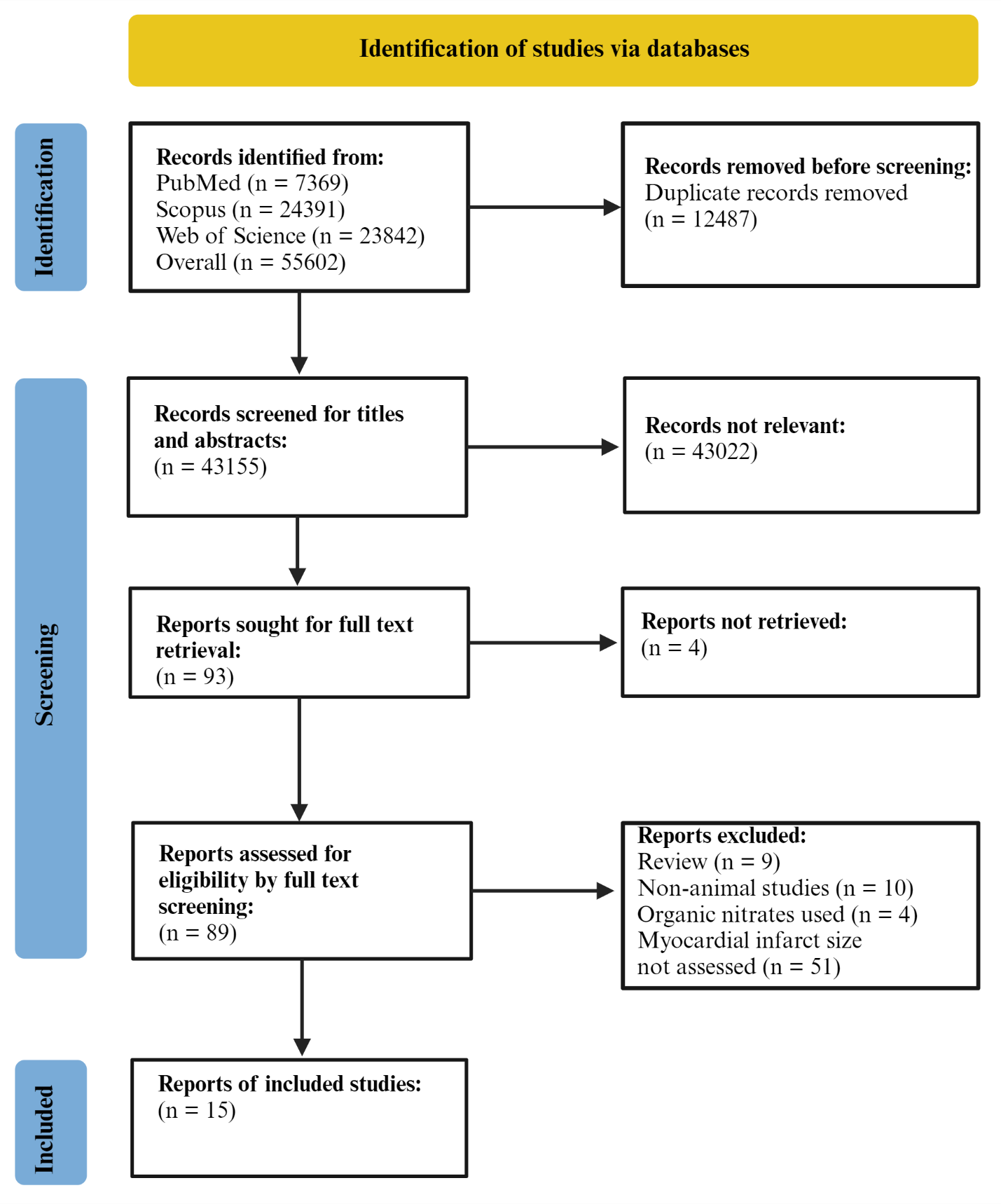Myocardial infarct size is reduced by nitrite and nitrate administration
a systematic review and meta-analysis of animal studies
DOI:
https://doi.org/10.17179/excli2023-6740Keywords:
nitrite, nitrate, myocardial infarction, ischemia-reperfusion injury, infarct size, cardioprotectionAbstract
Ischemic heart disease (IHD) is the leading cause of mortality worldwide and can be complicated by myocardial infarction (MI), leading to cardiac failure. Inorganic nitrite and nitrate, which release nitric oxide (NO), can protect the heart against myocardial injury. This animal systematic review and meta-analysis aims to assess whether the administration of nitrite/nitrate decreases myocardial infarct size. We systematically searched PubMed, Scopus, and Web of Science databases until October 2023; 15 eligible animal studies (35 study arms for in-vivo and 10 for in-vitro studies) published between 1989 and 2023 were included. In-vivo studies were conducted on rats, mice, cats, and dogs, and in-vitro studies on rats and mice with an overall exposure of 0.03 to 12713 mg/kg to nitrate/nitrite administrated before, after, or during ischemia mainly by intravenous single bolus or by oral over 270 days. All in-vitro studies used nitrite/nitrate before ischemia, with the concentration ranging between 0.34 to 201 μM. MI was induced by occlusion of the left anterior diagonal or left circumflex arteries in in-vitro studies and by isoproterenol in in-vivo studies. Infarct size was measured by direct staining of the sliced heart sections. In in-vivo studies, nitrite (overall effect size (ES)=-17.0 %, 95 % confidence interval (CI)=-21.3, -12.8, P<0.001) and nitrate (overall ES= -9.6 %, 95 % CI=-15.7, -3.4, P=0.002) reduced myocardial infarct size. In in-vitro studies, nitrite (overall ES=-15.8 %, 95 % CI=-25.5, -6.2, P=0.001) reduced the infarct size. Sensitivity analysis showed that the overall effect of nitrite on myocardial infarct size was unaffected by doses or health conditions in in-vivo and in-vitro studies. In conclusion, our meta-analysis showed that nitrite/nitrate administration can effectively reduce myocardial infarct size. However, these results should be approached with caution because of the limitations of animal studies and the existing high heterogeneity.

Downloads
Additional Files
Published
How to Cite
License
Copyright (c) 2024 Younes Yassaghi, Sajad Jeddi, Khosrow Kashfi, Asghar Ghasemi

This work is licensed under a Creative Commons Attribution 4.0 International License.
Authors who publish in this journal agree to the following terms:
- The authors keep the copyright and grant the journal the right of first publication under the terms of the Creative Commons Attribution license, CC BY 4.0. This licencse permits unrestricted use, distribution and reproduction in any medium, provided that the original work is properly cited.
- The use of general descriptive names, trade names, trademarks, and so forth in this publication, even if not specifically identified, does not imply that these names are not protected by the relevant laws and regulations.
- Because the advice and information in this journal are believed to be true and accurate at the time of publication, neither the authors, the editors, nor the publisher accept any legal responsibility for any errors or omissions presented in the publication. The publisher makes no guarantee, express or implied, with respect to the material contained herein.
- The authors can enter into additional contracts for the non-exclusive distribution of the journal's published version by citing the initial publication in this journal (e.g. publishing in an institutional repository or in a book).





